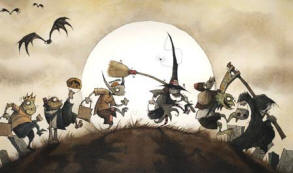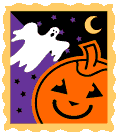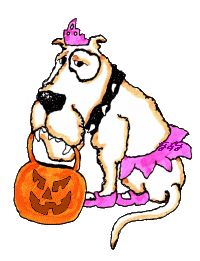|
 Trick-or-treating is the most widely recognized Halloween tradition.
It is an activity in which children go from house to house asking for
treats (i.e. candy) with the question, "Trick or treat?" Trick-or-treating is done with children donning
Halloween costumes and
it is one of the main traditions of Halloween. It has become socially
required that if one lives in a neighborhood with children to purchase
candy in preparation for trick-or-treaters. Trick-or-treating is the most widely recognized Halloween tradition.
It is an activity in which children go from house to house asking for
treats (i.e. candy) with the question, "Trick or treat?" Trick-or-treating is done with children donning
Halloween costumes and
it is one of the main traditions of Halloween. It has become socially
required that if one lives in a neighborhood with children to purchase
candy in preparation for trick-or-treaters.
Trick-or-treating declined
in the late 1970s and early '80s with the tainted candy scare. Hospitals
even got involved offering free x-ray scans of
Halloween candy. This
turned out to largely be an urban legend and trick-or-treating is making
somewhat of a comeback.


The American tradition of
"trick-or-treating" probably dates back to the early All Souls'
Day parades in England. During the festivities, poor citizens would beg
for food and families would give them pastries called "soul cakes"
in return for their promise to pray for the family's dead relatives.
The distribution of soul cakes
was encouraged by the church as a way to replace the ancient practice of
leaving food and wine for the returning spirits on Halloween night. The
practice, which was referred to as "going a-souling" was
eventually taken up by children who would visit the houses in their
neighborhood and be given ale, food, and money.
The tradition of dressing in costumes
and masks on Halloween finds its roots in both European and Celtic
history. On Halloween, when it was believed that ghosts came back to the
earthly realm, people thought they would encounter the ghosts if they
left their homes. Therefore, to avoid being seen by these ghosts, people
would wear masks when they left their homes after dark so that the
ghosts would mistake them for fellow spirits.
^ back to top


Holiday Hot Spots Offer Different
Trick-or-Treat Twists
 The National
Confectioners Association’s (NCA) 2006 National Trick-or-Treat
Traditions Survey asked Americans to pick their favorite city for
Halloween festivities. Each of the top five cities offer a different
twist to the trick-or-treat tradition: The National
Confectioners Association’s (NCA) 2006 National Trick-or-Treat
Traditions Survey asked Americans to pick their favorite city for
Halloween festivities. Each of the top five cities offer a different
twist to the trick-or-treat tradition:
Sunshine Spooktacular.
One-forth (25 percent) of Americans say trick-or-treating,
without a jacket, in Orlando is their top pick.
Ghosts, Goblins and Witches.
Nearly a quarter (23 percent) of trick-or-treaters chose Boston, a
city known for Halloween lore and traditions.
Star-Studded Evening.
Star-struck Americans chose Los Angeles as the “set” to don their
costumes. (15 percent)
Shop-n-Spook. Collecting candy and shopping in Minneapolis at Mall of
America tops the list for retail-minded revelers (13 percent).
Down-Home Halloween.
Tulsa draws a handful of trick-or-treaters (5
percent) for its hometown Halloween appeal.
^ back to top

S ources: ources:
The History Channel
http://www.history.com/minisite.do?content_type=mini_home&mini_id=1076
Spooky Halloween: Customs, Traditions and History. Hal Siemer (May 2006). Quest Magazine.
American Select Top "Trick-or-Treat Travel
Destinations , National
Confectioners Association, 2006 |

